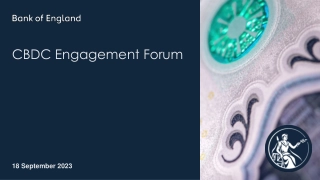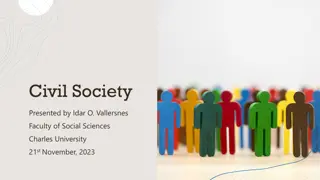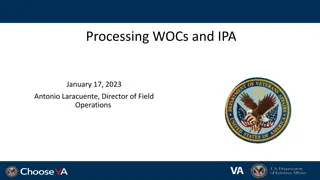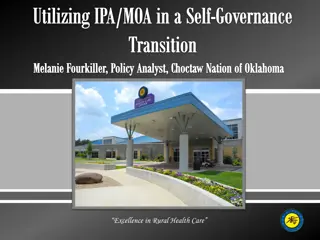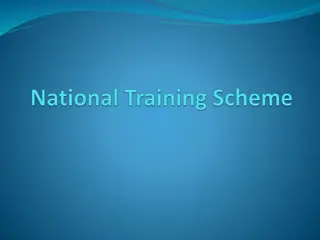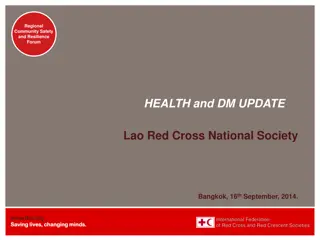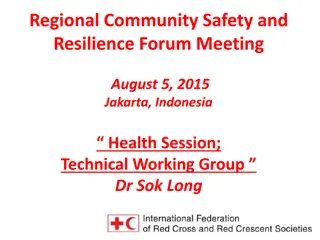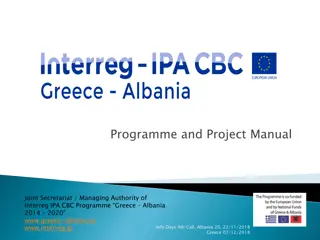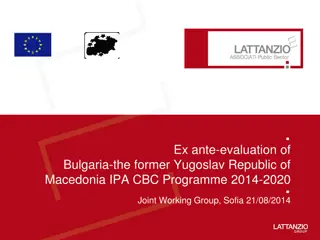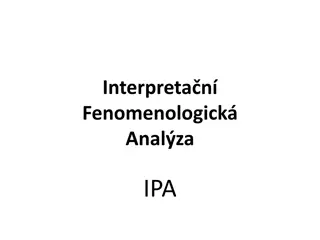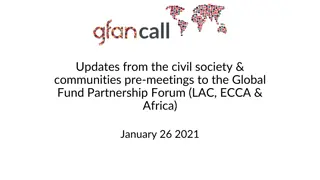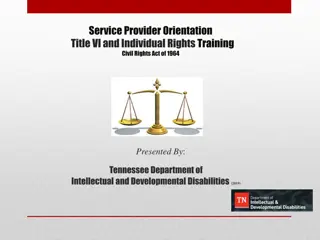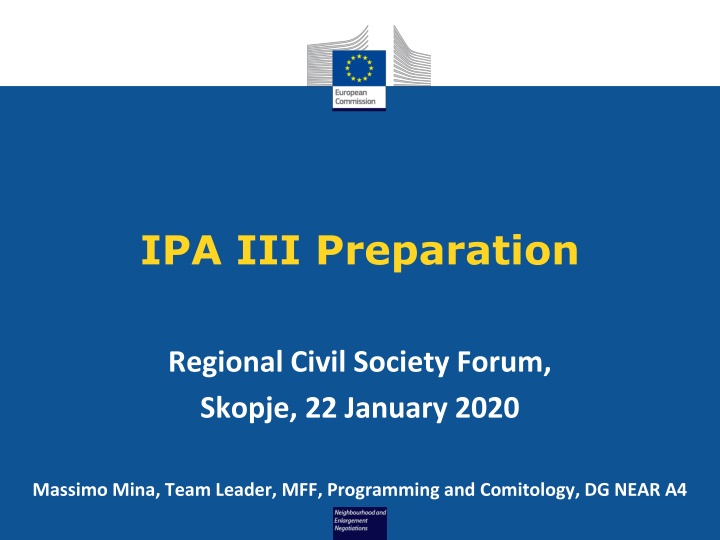
IPA III Preparation Regional Civil Society Forum
This presentation focuses on the European Commission's proposal for IPA III Regulation, covering the state of play of negotiations, legal framework, programming principles, and framework. It outlines the process, strategic response, and shift towards performance-based objectives in implementing IPA III. The content highlights the consultation process and key aspects of the programming framework.
Download Presentation

Please find below an Image/Link to download the presentation.
The content on the website is provided AS IS for your information and personal use only. It may not be sold, licensed, or shared on other websites without obtaining consent from the author. If you encounter any issues during the download, it is possible that the publisher has removed the file from their server.
You are allowed to download the files provided on this website for personal or commercial use, subject to the condition that they are used lawfully. All files are the property of their respective owners.
The content on the website is provided AS IS for your information and personal use only. It may not be sold, licensed, or shared on other websites without obtaining consent from the author.
E N D
Presentation Transcript
IPA III Preparation Regional Civil Society Forum, Skopje, 22 January 2020 Massimo Mina, Team Leader, MFF, Programming and Comitology, DG NEAR A4
Context This presentation is based on the European Commission proposal for IPA III Regulation, which was published on 14 June 2018 (see: https://ec.europa.eu/commission/sites/beta- political/files/budget-may2018-pre-accession- regulation_en.pdf Consultations on IPA III do not prejudge the final regulation, which will be adopted following trilogues with the Council and the European Parliament 2
State of play of IPA III negotiations Overall support from the Council and the European Parliament First IPA III trilogue on 12/12/2019. Next trilogue planned on 13/03/2020 Negotiations about IPA III are linked to NDICI ones and are part of the general package to be discussed and agreed with EU leaders on the overall EU budget 3
IPA III Legal Framework Cross-programme provisions - Erasmus - ERDF - Cohesion Fund - ESF+ - European Agricultural Fund for Rural Development - ETC NDICI REGULATION IPA III REGULATION SPECIFIC RULES FOR IMPLEMENTING IPA III IPA III PROGRAMMING FRAMEWORK 4
IPA III Programming in a nutshell No bilateral allocations defined upfront Five thematic windows Performance based Fair share principle Principles 5
IPA III Programming Framework Signature of Financing Agreement Strategic Response IPA III Programming Process Commission Financing Decision Relevance Assessment Submission of draft Action Documents Maturity Assessment 6
IPA III Programming Framework Shifts the focus to performance in achieving the objectives of the Regulation (Recital 18: Focus on results ). Principles Assistance planned through an IPA programming framework covering 5 windows to be adopted as a single Commission Decision through comitology. Strategy document for the five windows (content & indicative allocation) for the whole period 7
IPA III Programming Framework INTRODUCTION Overarching policy framework Overview of IPA III Programming Process If and where relevant, preferred financing and implementation methods Structure One Chapter per Thematic Window Strategic Objectives Key Priorities for IPA III Support Indicators Assumptions and Risks Indicative Allocation 8
IPA III Windows 1. Rule of law, fundamental Rights and democracy 2. Good governance, acquis alignment, strategic communication and good neighbourly relations 5. Territorial and cross border cooperation 4. Competitiveness and inclusive growth 3. Green agenda and sustainable connectivity 9
Cross-cutting / mainstreaming themes Climate change Civil society Gender Rights Based Approach Public Administration Reform (linked with fight against corruption) 10
Window 1: Rule of Law, Fundamental Rights and Democracy Strengthening the rule of law Overall Objective Democracy, respect of human rights and international law Enabling environment for civil society and strengthening capacity of civil society Security including law enforcement, judicial and police cooperation, fight against organised crime and terrorism Improve migration management, including border management Gender mainstreaming Key chapters: 23 and 24 11
Window 1: Rule of Law, Fundamental Rights and Democracy Thematic Priorities 1. Judiciary 2. Fight against corruption 3. Fight against organised crime / security 4. Migration and border management 5. Fundamental rights 6. Democracy 7. Civil Society 12
Window 2: Good Governance, Acquis Alignment, Strategic Communication and Good Neighbourly Relations Overall Objective Promotion of good governance (focus on PAR, PFM and economic governance) Compliance and alignment with the acquis and Union s values, rules, standards and practices Peace and stability across the region People to people contacts Regional cooperation, reconciliation and good neighbourly relations Strategic communication 13
Window 2: Good Governance, Acquis Alignment, Strategic Communication and Good Neighbourly Relations Thematic Priorities 1. Good Governance a) PAR b) PFM c) Governance at sub-national levels d) Statistics e) Economic governance 2. Administrative capacity and acquis alignment 3. Good neighbourly relations and reconciliation 4. Strategic communication, monitoring, evaluation and audit 14
Window 3: Green Agenda and sustainable connectivity Overall Objective Environmental protection Mitigation of and resilience to climate change Shift towards a low-carbon economy Digital economy and society Connectivity of the IPA III beneficiaries to the EU and the wider global market 15
Window 3: Green Agenda and sustainable connectivity Thematic Priorities 1. Environment and climate change 2. Transport, digital economy and society, and energy 16
Window 4: Competitiveness and inclusive growth Overall Objective Economic and social development Focus on education, social inclusion and employment policies Support to private sector development Agriculture and rural development 17
Window 4: Competitiveness and inclusive growth Thematic Priorities 1. Education, employment, social protection and inclusion policies, and health 2. Private sector development, trade, research and innovation 3. Agriculture and rural development 4. Fisheries 18
Window 5: Territorial and Cross-border Cooperation Strategic Objectives Promote reconciliation, confidence building and good neighbourly relations Contribute to economic, social and territorial development of border areas Support capacity building of local, authorities and stakeholders to implement structural and investment funds under territorial cooperation goal of the cohesion policy 19
Window 5: Territorial and Cross-border Cooperation Thematic Priorities Defined in Annex III of the IPA III Regulation Clustered in five priority areas of cooperation 1. Improved employment opportunities and social rights 2. Greener and improved resource efficiency 3. Improved public infrastructures / connectivity (transport, digital, energy, waste and water) 4. Improved business environment and competiveness 5. Improved capacity of local and regional authorities to tackle local challenges 20
IPA III Windows: Indicative Allocations (IPA II Projections) 3. Green agenda and sustainable connectivity 1. Rule of law, fundamental rights and democracy 2. Good governance, acquis alignment, good neighbourly relations and strategic communication About 30% of the total indicative allocation under IPA II About 20% of the total indicative allocation under IPA II About 15% of the total indicative allocation under IPA II 4. Competitiveness and inclusive growth 5. Territorial and cross border cooperation About 5% of the total indicative allocation under IPA II Up to 3% of the total financial envelope shall be indicatively allocated to CBC programmes between IPA III beneficiaries and the Member States. About 30% of the total indicative allocation under IPA II 21
Strategic Response Prepared by each IPA III beneficiary Outlining how the beneficiaries overall policies and sectoral strategies will contribute to the objectives of the IPA III Programming Framework Including a description of how IPA III funding opportunities are planned to be used over three programming years, in each window, per thematic priority 22
Strategic Response Part 1 Sector context and relevance with the enlargement process For each window: Sectoral context Coherence with the enlargement process Continuation of Sector Approach EU enlargement strategy Relevant national, regional and global strategies Part 2 Priorities, objectives and actions under IPA assistance Key thematic priorities List of actions proposed for IPA III support (including draft Action Documents) Indicative budget and implementation plan over three years
Programming process: Assessment of Actions Selection in two stages: First selection on policy relevance Based on part 2 of strategic response Only actions that will receive green light at this stage will be considered in the second stage Second selection on technical maturity Based on Action documents and supporting documents Only actions sufficiently mature will be considered ready for adoption Those not mature enough but policy relevant can be submitted when mature at a later stage (e.g. following year) 24
Key questions for civil society organisations Do you think that there are thematic priorities or other important elements missing in the proposed structure of the programming framework? Do you have any specific suggestions in relation to the process of preparation of the strategic response by IPA III beneficiaries? Do you have any specific suggestions relating to how support of civil society is reflected in the programming framework? Do you have any other comment or suggestion? 25
Contacts Please send your replies to the key questions to TACSO by 02/03/2020 at the following address: welcome@tacso.eu For general questions about IPA III preparations please contact: NEAR-IPA@ec.europa.eu 26


